Quick Look
Grade Level: 8 (6-8)
Time Required: 30 minutes
Lesson Dependency: None
Subject Areas: Physical Science
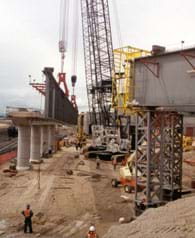
Summary
Students learn about the major factors that comprise the design and construction cost of a modern bridge. Before a bridge design is completed, engineers provide overall cost estimates for construction of the bridge. Students learn about the components that go into estimating the total cost, including expenses for site investigation, design, materials, equipment, labor and construction oversight, as well as the tradeoff between a design and its cost.Engineering Connection
When designing large and important structures such as bridges, engineers conduct research before they even think about possible designs. To create safe and long-lasting bridges requires great attention to detail; from environmental and geology site investigations, to the requirements analysis, to the design and materials, to the total costs and timeline. The many preliminary studies to gather data are followed by a cost analysis. Engineers strive to be efficient in terms of time and money spent; their objective is to devise the safest, most suitable, and most aesthetically-pleasing design, within a specified budget.
Learning Objectives
After this lesson, students should be able to:
- List several factors that influence bridge cost.
- Describe the importance for engineers of balancing bridge cost with bridge design.
Educational Standards
Each TeachEngineering lesson or activity is correlated to one or more K-12 science,
technology, engineering or math (STEM) educational standards.
All 100,000+ K-12 STEM standards covered in TeachEngineering are collected, maintained and packaged by the Achievement Standards Network (ASN),
a project of D2L (www.achievementstandards.org).
In the ASN, standards are hierarchically structured: first by source; e.g., by state; within source by type; e.g., science or mathematics;
within type by subtype, then by grade, etc.
Each TeachEngineering lesson or activity is correlated to one or more K-12 science, technology, engineering or math (STEM) educational standards.
All 100,000+ K-12 STEM standards covered in TeachEngineering are collected, maintained and packaged by the Achievement Standards Network (ASN), a project of D2L (www.achievementstandards.org).
In the ASN, standards are hierarchically structured: first by source; e.g., by state; within source by type; e.g., science or mathematics; within type by subtype, then by grade, etc.
NGSS: Next Generation Science Standards - Science
-
SEP.12.6-8.1.
Use mathematical representations to describe and/or support scientific conclusions and design solutions.
(Grades 6 - 8)
More Details
Do you agree with this alignment?
Common Core State Standards - Math
-
Solve unit rate problems including those involving unit pricing and constant speed.
(Grade
6)
More Details
Do you agree with this alignment?
-
Fluently add, subtract, multiply, and divide multi-digit decimals using the standard algorithm for each operation.
(Grade
6)
More Details
Do you agree with this alignment?
-
Use ratio reasoning to convert measurement units; manipulate and transform units appropriately when multiplying or dividing quantities.
(Grade
6)
More Details
Do you agree with this alignment?
-
Solve real-world and mathematical problems involving area, volume and surface area of two- and three-dimensional objects composed of triangles, quadrilaterals, polygons, cubes, and right prisms.
(Grade
7)
More Details
Do you agree with this alignment?
State Standards
Colorado - Math
-
Fluently add, subtract, multiply, and divide multidigit decimals using standard algorithms for each operation.
(Grade
6)
More Details
Do you agree with this alignment?
-
Use ratio reasoning to convert measurement units.
(Grade
6)
More Details
Do you agree with this alignment?
-
Solve unit rate problems including those involving unit pricing and constant speed.
(Grade
6)
More Details
Do you agree with this alignment?
-
Solve real-world and mathematical problems involving area, volume and surface area of two- and three-dimensional objects composed of triangles, quadrilaterals, polygons, cubes, and right prisms.
(Grade
7)
More Details
Do you agree with this alignment?
Colorado - Science
-
Predict and evaluate the movement of an object by examining the forces applied to it
(Grade
8)
More Details
Do you agree with this alignment?
Worksheets and Attachments
Visit [www.teachengineering.org/lessons/view/cub_brid_lesson05] to print or download.Pre-Req Knowledge
Students should have some previous knowledge of bridges, including a familiarity with bridge types and bridge parts, as introduced in other lessons in the Bridges unit.
Introduction/Motivation
Have you ever wondered how much it costs to build a bridge? (Show images of the original and second Blue Water Bridges, as provided in the attached Blue Water Bridge PowerPoint presentation, or Figures 1 and 2.) This is the Blue Water Bridge, a major international crossing over the St. Clair River at the southern end of Lake Huron. It is located between Port Huron, Michigan and Point Edward, Ontario, Canada. Guess how much it cost to create the original bridge in 1938? (Write student guesses on the board.) How much do you think it cost to expand the bridge by building another one next to it in 1997? (Write student guesses on the board.)
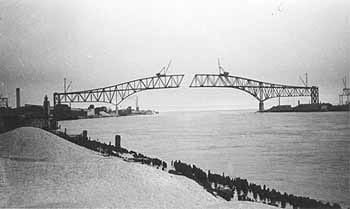
Construction of the original Blue Water Bridge, a cantilevered truss bridge, was completed in October 1938 (see Figure 1) with a total cost of about $4 million dollars. A collaborative US-Canada project, the bridge was funded with bonds and then repaid using toll collections. The bridge became toll-free 24 years later — just in time to begin thinking about expansion projects. In 1971 and again in 1985, tolls were reinstated and then increased to fund construction of an approach road on the Michigan side, and further improvements and expansion.
In 1997, a second Blue Water Bridge, a continuous-tied arch bridge, was built next to the original one (see Figure 2) with a total cost of about $107 million dollars. Michigan paid for half; Ontario paid for the other half. Then, renovations were made to the original bridge. Finally, in 1999, both bridges were in full operation. The original Blue Water Bridge carries three lanes of westbound traffic; the second Blue Water Bridge carries three lanes of eastbound traffic. On a busy day as many 20,000 vehicles cross from country to country.
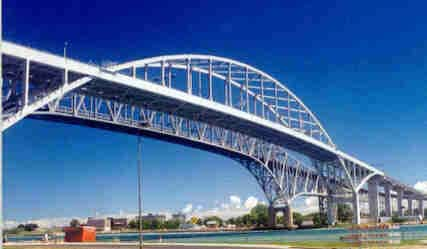
What big projects! How is the total cost of a bridge calculated? Or, more importantly, how is the cost of any bridge estimated before it is ever built?
Bridges are expensive (see Figures 3 and 4). Even a simple pedestrian bridge might cost $250,000. That is a quarter of a million dollars! As part of designing and constructing bridges, engineers pay close attention to the cost of a bridge. They must find a balance between the cost and size and materials, and design and safety of a bridge. If we had unlimited funds to build a bridge, it would be easy to over-design it to be able to handle just about anything. However, most communities do not have unlimited money. So, engineers come up with an optimum design, one that best meets the requirements for the bridge with careful consideration for the cost to build it and safety. Students can act as engineers in the associated activity Cost Comparisons to learn about the many types of expenses associated with creating a bridge.
Usually, different engineering teams (companies) create bid proposals for a bridge project that each include an estimate of what it would cost to build their design. The company or city who is hiring the engineers chooses the design that best fits their needs and is within their budget. Then, the chosen engineering firm must make sure to design a bridge that can be built within the estimate they proposed. What factors might be most important to consider in estimating the cost of a bridge? (Collect student ideas; possible answers: cost of preliminary studies to gather information on the site, choice of materials, amount of materials used, cost to transport materials, construction equipment, costs to re-route traffic, cost of labor, costs for design and construction management.)
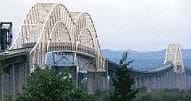
Several factors influence bridge cost. First (and sometimes foremost) is the type and amount of material used. For example, a bridge with beams and girders that are half the size of another bridge, with everything else being equal, would be less expensive. Another important factor is the labor required to build a bridge. In some locations, this can be the most important factor if the cost of labor is very high. In this case, keeping labor costs down by using fewer bridge members can be cost effective. However, using fewer members may require them to be larger, which may affect the bridge design. Other factors include the cost to transport materials (trucks, ferries), equipment to build the bridge (such as cranes), and other expenses such as environmental and preliminary studies, traffic re-routing, and administrative expenses such as hiring engineers to design the bridge and manage its construction.
Due to the huge cost of designing and building a bridge, it becomes important to justify why the bridge is needed. If a bridge is going to cost hundreds of thousands of dollars or more, then the need for and use of the bridge should be researched, as well as the safety of the bridge for its intended use. This brings us back to the task of identifying the purpose and requirements of a bridge for a particular location, for the role of connecting people to resources, places and other people.
We want bridge designs to stay within the budget for completion. Sometimes, if a bridge project estimate is more than the available budget, the building is delayed until additional funds can be found. Other times, money is pulled in from other ways, like through taxes or tolls on the people in the community. Engineers intend to create bid proposals that are realistic; however, sometimes environmental factors can influence an intended design and raise the costs of the final product. Above all, the safety of the bridge is the most important feature that engineers want to make sure is not compromised.
There are various other constraints to designing a bridge in addition to the cost constraint. Design constraints play a major role in influencing the bridge project. Among these constraints include, the span of the bridge and its self weight. The bridge length may be limited depending on bridge type (i.e., beam, arch, suspension or truss bridge) or bridge material (i.e., steel, concrete, timber). Additionally, environmental constraints are considered. Engineers must consider whether they are building in environmentally sensitive areas and consider noise and air pollution during construction. Also, traffic and pedestrian access as well as overall bridge operation need to be considered. Furthermore, legal constraints are considered such as ensuring laws, regulations or building codes are abided by.
Lesson Background and Concepts for Teachers
Nearly every city has bridges and the stories behind these bridges reveal how we tackle engineering problems. When bidding on a large construction project such as a bridge, a construction contractor must have an idea of what they are agreeing to build. Engineers must understand the factors that influence cost, what goes into calculating the total cost of a bridge, and the value of optimizing the cost and design of the bridge.
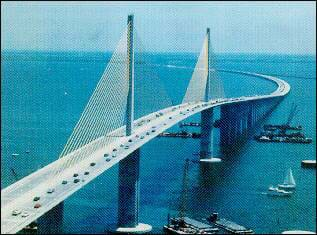
Total Cost of a Bridge
Many expenses associated with the total cost of building a bridge. However, analyzing a few key factors is enough to estimate the "ballpark cost" of a bridge. First, consider the cost of the material used. Calculating the volume of all of the members of the bridge gives the total amount of material in the bridge. The cost of the material is usually calculated by its amount or weight. Then, multiply the amount of material volume by the cost of material per volume to get the entire cost of the material. The cost of labor and equipment are also both important cost components to include. A site investigation needs to be completed before determining the final design. Finally, administrative expenses must be considered. In sum, the primary costs to create a bridge include:
- concrete
- steel
- equipment
- soil/site investigation
- design engineer
- field engineer
Optimizing the Cost and Design of a Bridge
With the known costs for research, design, materials, labor, equipment, transportation and administration, engineers must optimize or find the best design for the least amount of money. Optimizing the design often produces the most cost-efficient and effective design. Engineers must also incorporate factors for safety, because they do not want the system to fail. This can involve balancing trade-offs, such as aesthetics for strength of materials, or can cause a project to go over budget.
Associated Activities
- Cost Comparisons - Students learn about the many types of expenses associated with creating a bridge. They estimate and compare the costs of girders made of concrete and steel, and of different sizes. They graph and analyze their results, and create a proposal for a city bridge design based on their findings.
Lesson Closure
Think of bridges around your community — on roadways or bike paths or pedestrian paths. How much to you think those bridges cost to design and build? Which cost the most? Which cost the least? Engineers think about cost when creating bridge designs. To prepare bid proposals for bridge projects, engineers think about the materials they plan to use. What are some other factors of specific bridges that might make them more expensive to build? (Possible answers: Site and soil investigations, cost to transport materials, toll/customs/security booths, high costs for local labor, etc.)
Why does it matter to us that engineers are careful to balance the cost of a bridge with their design decisions? Well, first of all, we want bridges to be safe. We want the materials to be strong and not break or fail under the required loads (people, traffic, weather) that affect them every day. We also want a new bridge to stay within the available budget set aside to build the bridge; we do not want to have to stop completion of the bridge because we run out of money, or have to pay for it through unanticipated tolls and taxes for years to come.
Vocabulary/Definitions
bidding: When a group of contractors or builders compete for the work (job) to create a project, such as a bridge.
budget: The amount of money available for a project, such as creating a bridge.
cost: The amount of money needed to build a project, such as a bridge.
design: (verb) To plan out in systematic, often graphic form. To create for a particular purpose or effect. Design a bridge. (noun) A well thought-out plan.
engineer: A person who applies her/his understanding of science and mathematics to creating things for the benefit of humanity and our world.
engineering: Applying scientific and mathematical principles to practical ends such as the design, manufacture and operation of efficient and economical structures, machines, processes and systems.
estimating: An accurate determination of the cost of the project (such as a bridge) before construction begins.
girder: The "beam" of a bridge; usually horizontal member.
load: Any of the forces that a structure is calculated to oppose, comprising any unmoving and unvarying force (dead load), any load from wind or earthquake, and any other moving or temporary force (live load).
member: An individual angle, beam, column, plate or built piece intended to become an integral part of an assembled frame or structure.
optimal design: Balancing the cost and design of the bridge so that the least amount of money accomplishes the required task effectively.
pier: The "column" of a bridge; usually vertical member.
Assessment
Pre-Lesson Assessment
Estimation: Show students photographs of the 1938 and 1997 Blue Water Bay Bridges and ask them to guess how much they each cost to design and build. Write their guesses on the board.
Post-Introduction Assessment
Question/Answer: Ask students to discuss what factors are most important in the cost of a bridge (Possible answers: Cost of preliminary studies to gather information on the site, choice of materials, amount of materials used, cost to transport materials, construction equipment, costs to re-route traffic, cost of labor, costs for design and construction management.)
Lesson Summary Assessment
Worksheet: Have students complete the attached Total Bridge Cost Worksheet to determine the cost of a bridge. Review their answers to gauge mastery of the subject.
Lesson Extension Activities
Specific Bridge Research: Assign students to individually research a specific bridge of their choosing (famous or local) and determine its cost. Investigate at the library or on the internet, or for local bridges, research at the city hall or county records facility. At the next class period, have each student make a brief class presentation that describes the bridge type, location and cost. Suggestion: the departments of transportation for most states provide good information about their road and bridge projects under construction. For example, see the Michigan Department of Transportation website.
Extra Credit History Research & Reporting: Most people don't know that Emily Warren Roebling was the person in charge of the day-to-day construction of the Brooklyn Bridge. Conceived by her father-in-law, John A Roebling, the Brooklyn Bridge is one of the largest engineering projects in America's history. In the late 1800s, there was no greater challenge than spanning the East River from Brooklyn to New York. Offer extra credit to students who research and report back to the class on how Emily ended up serving as chief engineer after her father-in-law died and her husband fell ill.
Subscribe
Get the inside scoop on all things TeachEngineering such as new site features, curriculum updates, video releases, and more by signing up for our newsletter!More Curriculum Like This

Working like engineers, students estimate the cost for materials for a bridge member of varying sizes. After making calculations, they graph their results to compare how costs change depending on the use of different materials (steel vs. concrete).

Students are presented with a brief history of bridges as they learn about the three main bridge types: beam, arch and suspension. They are introduced to two natural forces — tension and compression — common to all bridges and structures.

Learn the basics of the analysis of forces engineers perform at the truss joints to calculate the strength of a truss bridge known as the “method of joints.” Find the tensions and compressions to solve systems of linear equations where the size depends on the number of elements and nodes in the trus...

Working as engineering teams, students design and create model beam bridges using plastic drinking straws and tape as their construction materials. Their goal is to build the strongest bridge with a truss pattern of their own design, while meeting the design criteria and constraints.
References
Blue Water Bridge. Michigan Department of Transportation, Accessed October 16, 2007. http://www.michigan.gov/mdot/0,1607,7-151-9618_11070---,00.html
Blue Water Bridge. Last updated September 23, 2007. Wikipedia, the free encyclopedia. Accessed October 16, 2007. http://en.wikipedia.org/wiki/Blue_Water_Bridge
Bridge Statistics & Trivia, Blue Water Bridge. Michigan Department of Transportation. Accessed October 16, 2007. http://www.michigan.gov/mdot/0,1607,7-151-9618_11070-26182--,00.html
Get a Quote on Nearly Any Construction Material. Get-A-Quote.net. Accessed October 16, 2007. http://www.get-a-quote.net/
International Bridge History. Michigan Department of Transportation, Accessed August 21, 2012. http://www.michigan.gov/mdot/0,4616,7-151-9618_48384-23856--,00.html
International Bridge, Sault Ste. Marie. Michigan Department of Transportation, Accessed August 21, 2012. http://www.michigan.gov/mdot/0,1607,7-151-9618_48384---,00.html
Newnan, Donald G. and Lavelle, Jerome P. Engineering Economic Analysis, Seventh Edition. Engineering Press: Austin, TX, 1998.
Weingroff, Richard F. Engineering Marvels: Dwight D. Eisenhower System of Interstate and Defense Highways. Public Roads Magazine, published Summer 1996. Federal Highway Administration, US Department of Transportation. Accessed October 16, 2007. http://www.tfhrc.gov/pubrds/summer96/p96su28.htm
Copyright
© 2007 by Regents of the University of Colorado.Contributors
Jonathan S. Goode; Joe Friedrichsen; Natalie Mach; Christopher Valenti; Denali Lander; Denise W. Carlson; Malinda Schaefer ZarskeSupporting Program
Integrated Teaching and Learning Program, College of Engineering, University of Colorado BoulderAcknowledgements
The contents of this digital library curriculum were developed under a grant from the Fund for the Improvement of Postsecondary Education (FIPSE), U.S. Department of Education and National Science Foundation GK-12 grant no. 0338326. However, these contents do not necessarily represent the policies of the Department of Education or National Science Foundation, and you should not assume endorsement by the federal government.
Last modified: July 25, 2022









User Comments & Tips